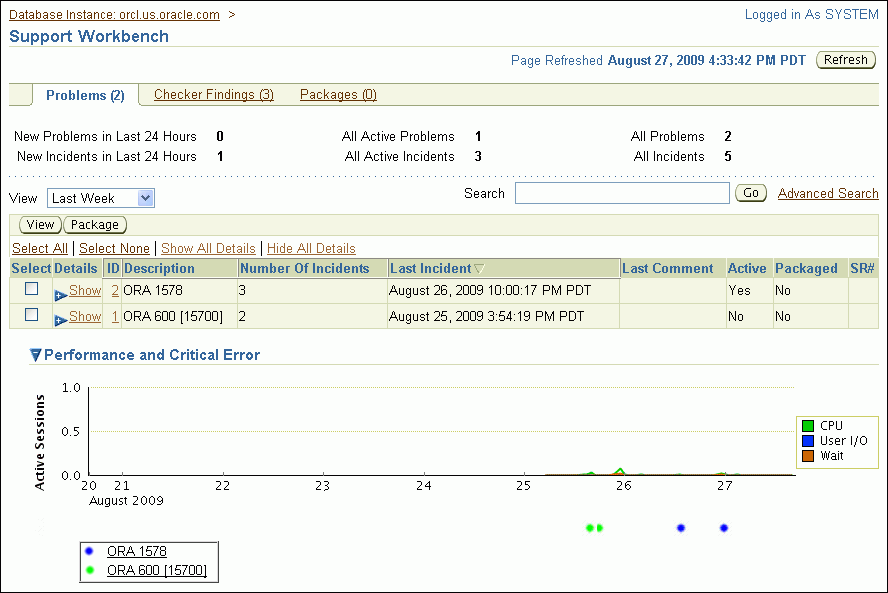| Oracle® Database Administrator's Guide 11g Release 2 (11.2) Part Number E25494-02 |
|
|
PDF · Mobi · ePub |
| Oracle® Database Administrator's Guide 11g Release 2 (11.2) Part Number E25494-02 |
|
|
PDF · Mobi · ePub |
You use the Enterprise Manager Support Workbench home page (Figure 9-5) to view all problems or only those within a specified time period.
Figure 9-5 Enterprise Manager Support Workbench Home Page

To access the Support Workbench home page (database or Oracle ASM):
Access the Database Home page in Enterprise Manager.
See Oracle Database 2 Day DBA for the instructions for Oracle Enterprise Manager Database Control. For Oracle Enterprise Manager Grid Control, go to the desired database target.
Do one of the following:
In the Diagnostic Summary section, click the numeric link next to the label Active Incidents.
At the top of the page, click Software and Support, and then under Support, click Support Workbench.
The Support Workbench home page for the database instance appears, showing the Problems subpage. By default the problems from the last 24 hours are displayed.
To view the Support Workbench home page for the Oracle ASM instance, click the link Support Workbench (+ASM_hostname) in the Related Links section.
To view problems and incidents:
On the Support Workbench home page, select the desired time period from the View list. To view all problems, select All.
(Optional) If the Performance and Critical Error section is hidden, click the Show/Hide icon adjacent to the section heading to show the section.
This section enables you to view any correlation between performance changes and incident occurrences.
(Optional) Under the Details column, click Show to display a list of all incidents for a problem, and then click an incident ID to display the Incident Details page.
To view details for a particular problem:
On the Support Workbench home page, select the problem, and then click View.
The Problem Details page appears, showing the Incidents subpage. The incidents subpage shows all incidents that are open and that generated dumps—that is, that were not flood-controlled.
(Optional) To view both open and closed incidents, select All Incidents in the Status list. To view both normal and flood-controlled incidents, select All Incidents in the Data Dumped list.
(Optional) To view details for an incident, select the incident, and then click View.
The Incident Details page appears.
(Optional) On the Incident Details page, to view checker findings for the incident, click Checker Findings.
(Optional) On the Incident Details page, to view the user actions that are available to you for the incident, click Additional Diagnostics. Each user action provides a way for you to gather additional diagnostics for the incident or its problem.
See Also:
"Incident Flood Control"